Page 291 of 587
CAUTION!(Continued)
clutch damage, even if the clutch pedal is pressed.
If transfer case is in low range the vehicle speeds to
cause engine and clutch damage are significantly
lower.
• Failure to follow the maximum recommended
downshifting speeds may cause the engine damage
and/or damage the clutch, even if the clutch pedal
is pressed.
• Descending a hill in low range with clutch pedal
depressed could result in clutch damage.
Maximum Recommended Downshift Speeds
CAUTION!
Failure to follow the maximum recommended down-
shifting speeds may cause the engine to overspeed
and/or damage the clutch disc, even if the clutch
pedal is pressed.
Manual Transmission Shift Speeds in MPH (KM/H)
Gear Selection 6 to 5 5 to 44 to 33 to 2 2 to 1
Maximum Speed 80 (129)
70 (113) 50 (81)30 (48) 15 (24)
7
STARTING AND OPERATING 289
Page 292 of 587
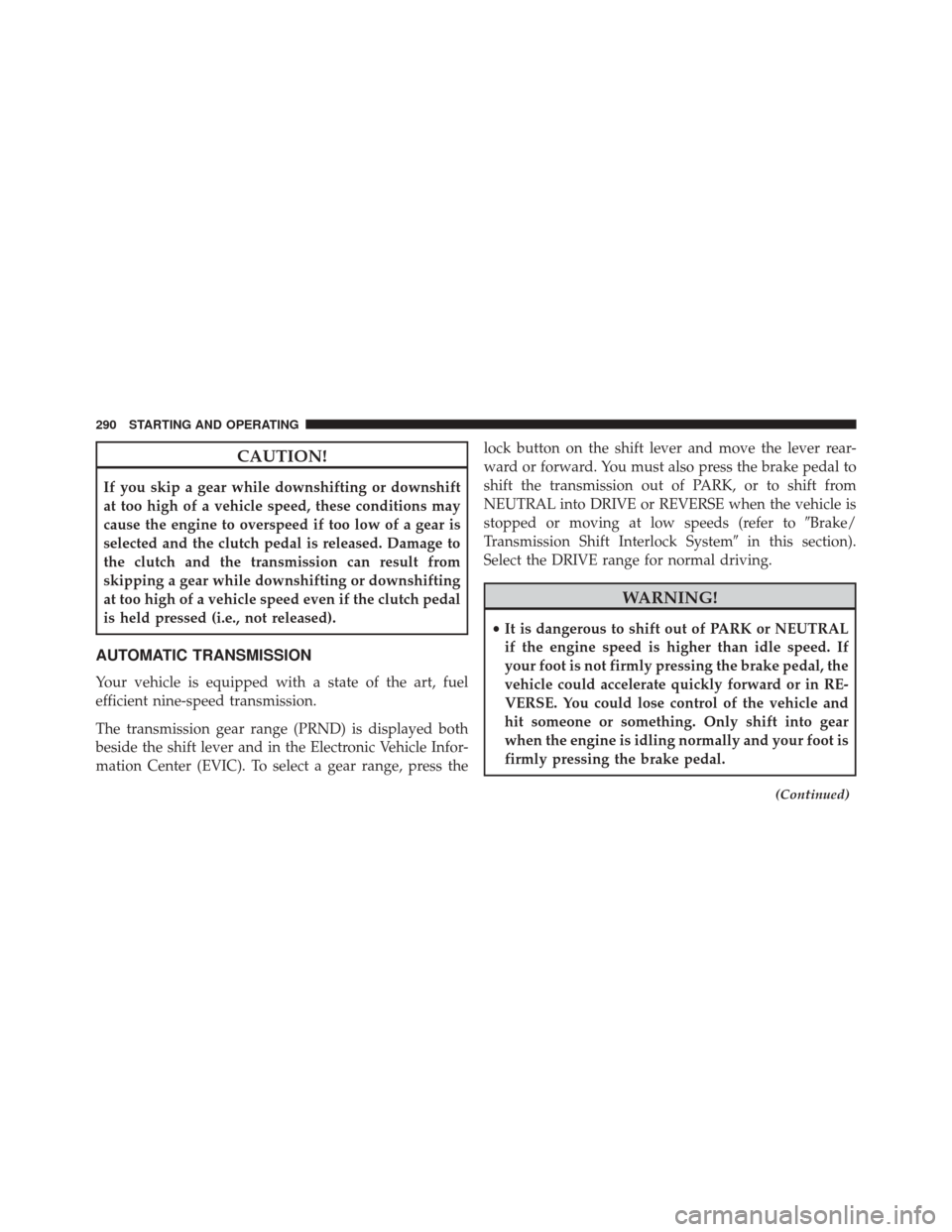
CAUTION!
If you skip a gear while downshifting or downshift
at too high of a vehicle speed, these conditions may
cause the engine to overspeed if too low of a gear is
selected and the clutch pedal is released. Damage to
the clutch and the transmission can result from
skipping a gear while downshifting or downshifting
at too high of a vehicle speed even if the clutch pedal
is held pressed (i.e., not released).
AUTOMATIC TRANSMISSION
Your vehicle is equipped with a state of the art, fuel
efficient nine-speed transmission.
The transmission gear range (PRND) is displayed both
beside the shift lever and in the Electronic Vehicle Infor-
mation Center (EVIC). To select a gear range, press thelock button on the shift lever and move the lever rear-
ward or forward. You must also press the brake pedal to
shift the transmission out of PARK, or to shift from
NEUTRAL into DRIVE or REVERSE when the vehicle is
stopped or moving at low speeds (refer to
�Brake/
Transmission Shift Interlock System �in this section).
Select the DRIVE range for normal driving.
WARNING!
• It is dangerous to shift out of PARK or NEUTRAL
if the engine speed is higher than idle speed. If
your foot is not firmly pressing the brake pedal, the
vehicle could accelerate quickly forward or in RE-
VERSE. You could lose control of the vehicle and
hit someone or something. Only shift into gear
when the engine is idling normally and your foot is
firmly pressing the brake pedal.
(Continued)
290 STARTING AND OPERATING
Page 293 of 587
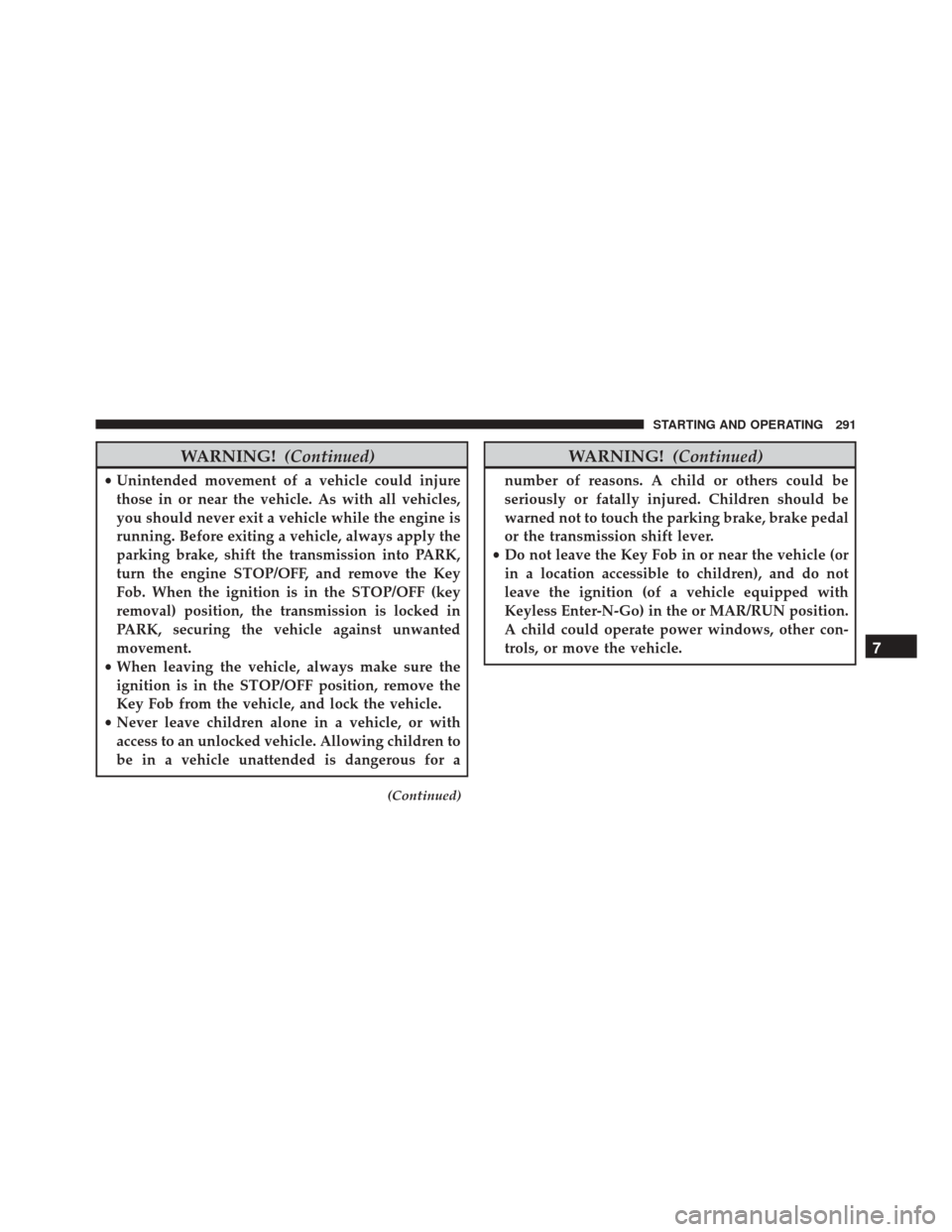
WARNING!(Continued)
•Unintended movement of a vehicle could injure
those in or near the vehicle. As with all vehicles,
you should never exit a vehicle while the engine is
running. Before exiting a vehicle, always apply the
parking brake, shift the transmission into PARK,
turn the engine STOP/OFF, and remove the Key
Fob. When the ignition is in the STOP/OFF (key
removal) position, the transmission is locked in
PARK, securing the vehicle against unwanted
movement.
• When leaving the vehicle, always make sure the
ignition is in the STOP/OFF position, remove the
Key Fob from the vehicle, and lock the vehicle.
• Never leave children alone in a vehicle, or with
access to an unlocked vehicle. Allowing children to
be in a vehicle unattended is dangerous for a
(Continued)
WARNING! (Continued)
number of reasons. A child or others could be
seriously or fatally injured. Children should be
warned not to touch the parking brake, brake pedal
or the transmission shift lever.
• Do not leave the Key Fob in or near the vehicle (or
in a location accessible to children), and do not
leave the ignition (of a vehicle equipped with
Keyless Enter-N-Go) in the or MAR/RUN position.
A child could operate power windows, other con-
trols, or move the vehicle.
7
STARTING AND OPERATING 291
Page 294 of 587
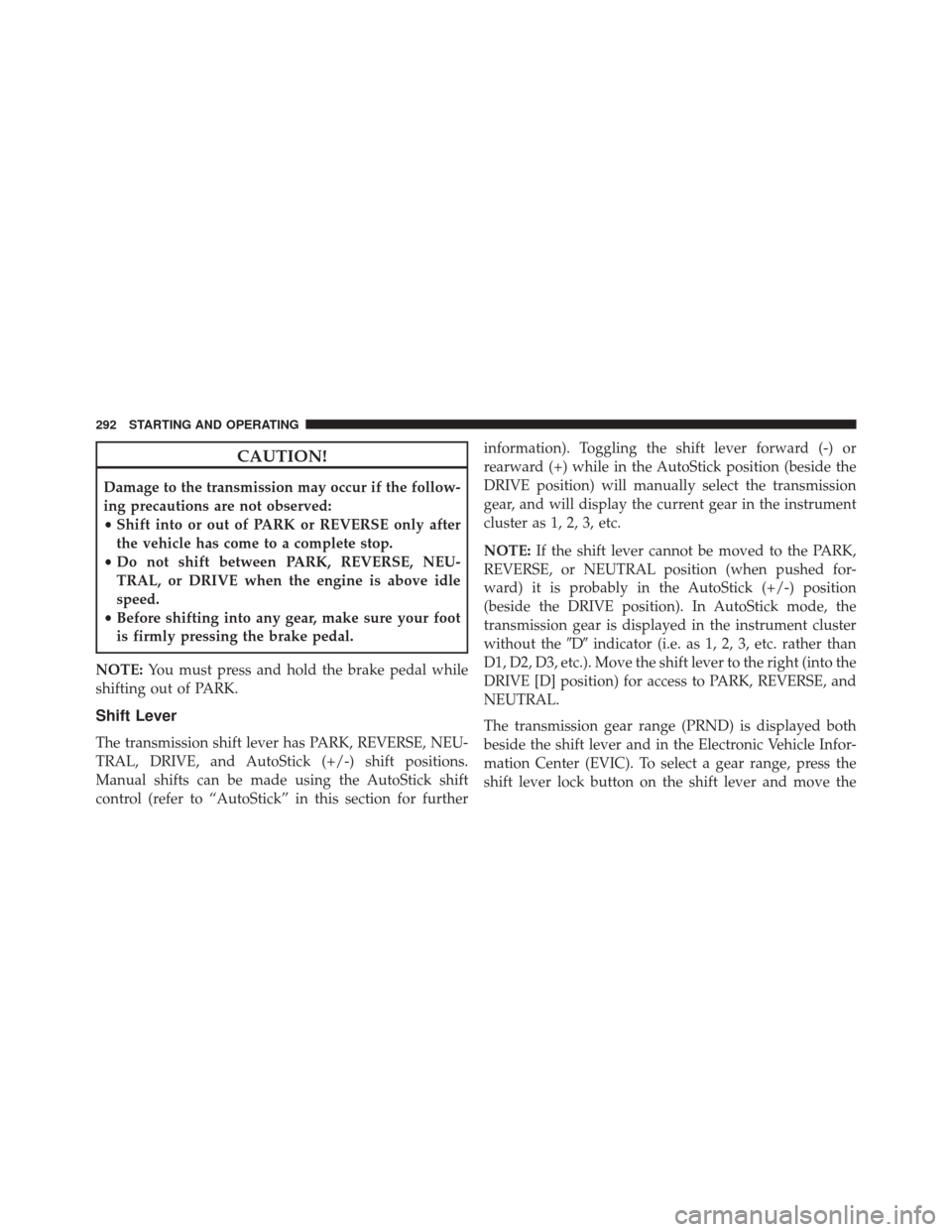
CAUTION!
Damage to the transmission may occur if the follow-
ing precautions are not observed:
•Shift into or out of PARK or REVERSE only after
the vehicle has come to a complete stop.
• Do not shift between PARK, REVERSE, NEU-
TRAL, or DRIVE when the engine is above idle
speed.
• Before shifting into any gear, make sure your foot
is firmly pressing the brake pedal.
NOTE: You must press and hold the brake pedal while
shifting out of PARK.
Shift Lever
The transmission shift lever has PARK, REVERSE, NEU-
TRAL, DRIVE, and AutoStick (+/-) shift positions.
Manual shifts can be made using the AutoStick shift
control (refer to “AutoStick” in this section for further information). Toggling the shift lever forward (-) or
rearward (+) while in the AutoStick position (beside the
DRIVE position) will manually select the transmission
gear, and will display the current gear in the instrument
cluster as 1, 2, 3, etc.
NOTE:
If the shift lever cannot be moved to the PARK,
REVERSE, or NEUTRAL position (when pushed for-
ward) it is probably in the AutoStick (+/-) position
(beside the DRIVE position). In AutoStick mode, the
transmission gear is displayed in the instrument cluster
without the �D�indicator (i.e. as 1, 2, 3, etc. rather than
D1, D2, D3, etc.). Move the shift lever to the right (into the
DRIVE [D] position) for access to PARK, REVERSE, and
NEUTRAL.
The transmission gear range (PRND) is displayed both
beside the shift lever and in the Electronic Vehicle Infor-
mation Center (EVIC). To select a gear range, press the
shift lever lock button on the shift lever and move the
292 STARTING AND OPERATING
Page 296 of 587
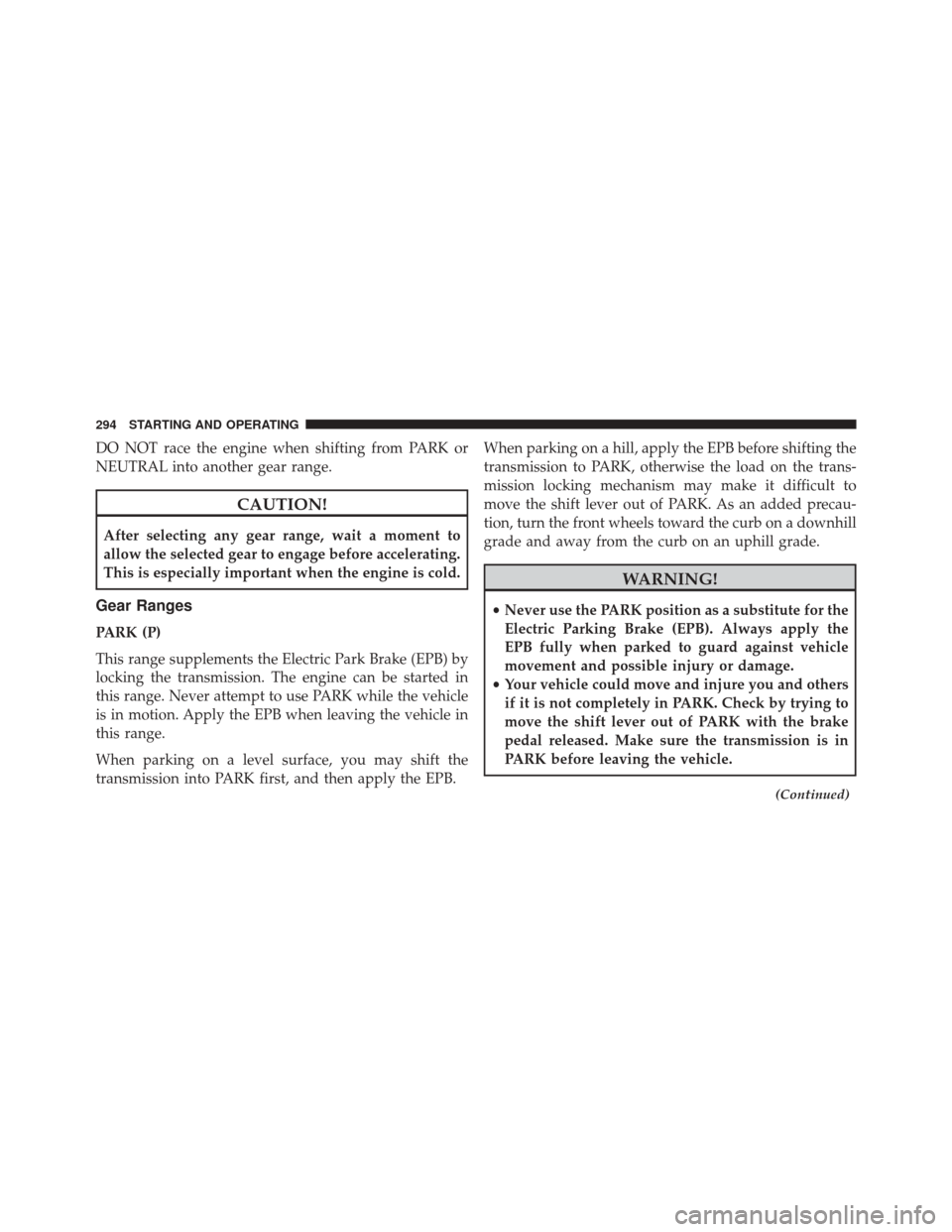
DO NOT race the engine when shifting from PARK or
NEUTRAL into another gear range.
CAUTION!
After selecting any gear range, wait a moment to
allow the selected gear to engage before accelerating.
This is especially important when the engine is cold.
Gear Ranges
PARK (P)
This range supplements the Electric Park Brake (EPB) by
locking the transmission. The engine can be started in
this range. Never attempt to use PARK while the vehicle
is in motion. Apply the EPB when leaving the vehicle in
this range.
When parking on a level surface, you may shift the
transmission into PARK first, and then apply the EPB.When parking on a hill, apply the EPB before shifting the
transmission to PARK, otherwise the load on the trans-
mission locking mechanism may make it difficult to
move the shift lever out of PARK. As an added precau-
tion, turn the front wheels toward the curb on a downhill
grade and away from the curb on an uphill grade.
WARNING!
•
Never use the PARK position as a substitute for the
Electric Parking Brake (EPB). Always apply the
EPB fully when parked to guard against vehicle
movement and possible injury or damage.
• Your vehicle could move and injure you and others
if it is not completely in PARK. Check by trying to
move the shift lever out of PARK with the brake
pedal released. Make sure the transmission is in
PARK before leaving the vehicle.
(Continued)
294 STARTING AND OPERATING
Page 297 of 587

WARNING!(Continued)
•It is dangerous to shift out of PARK or NEUTRAL
if the engine speed is higher than idle speed. If
your foot is not firmly pressing the brake pedal, the
vehicle could accelerate quickly forward or in RE-
VERSE. You could lose control of the vehicle and
hit someone or something. Only shift into gear
when the engine is idling normally and your foot is
firmly pressing the brake pedal.
• Unintended movement of a vehicle could injure
those in or near the vehicle. As with all vehicles,
you should never exit a vehicle while the engine is
running. Before exiting a vehicle, always apply the
EPB, shift the transmission into PARK, turn the
engine OFF, and remove the Key Fob. When the
ignition is in the STOP/OFF (key removal) posi-
tion, the transmission is locked in PARK, securing
the vehicle against unwanted movement.
(Continued)
WARNING! (Continued)
•When leaving the vehicle, always make sure the
ignition is in the STOP/OFF position, remove the
Key Fob from the vehicle, and lock the vehicle.
• Never leave children alone in a vehicle, or with
access to an unlocked vehicle. Allowing children to
be in a vehicle unattended is dangerous for a
number of reasons. A child or others could be
seriously or fatally injured. Children should be
warned not to touch the parking brake, brake pedal
or the shift lever.
• Do not leave the Key Fob in or near the vehicle (or
in a location accessible to children), and do not
leave the ignition (of a vehicle equipped with
Keyless Enter-N-Go) in the MAR/RUN position. A
child could operate power windows, other controls,
or move the vehicle.
7
STARTING AND OPERATING 295
Page 298 of 587

CAUTION!
•Before moving the shift lever out of PARK, you
must turn the ignition switch from the STOP/OFF
position to the MAR/RUN position, and also press
the brake pedal. Otherwise, damage to the shift
lever could result.
• DO NOT race the engine when shifting from
PARK or NEUTRAL into another gear range, as this
can damage the drivetrain.
The following indicators should be used to ensure that
you have engaged the transmission into the PARK posi-
tion:
• When shifting into PARK, press the LOCK button on
the shift lever and firmly move the shift lever all the
way forward until it stops and is fully seated.
• Look at the transmission gear position display and
verify that it indicates the PARK (P). •
With the brake pedal released, verify that the shift
lever will not move out of PARK.
Reverse (R)
This range is for moving the vehicle backward. Shift into
REVERSE only after the vehicle has come to a complete
stop.
Neutral (N)
Use this range when the vehicle is standing for prolonged
periods with the engine running. The engine may be
started in this range. Apply the EPB and shift the
transmission into PARK if you must leave the vehicle.
WARNING!
Do not coast in NEUTRAL and never turn off the
ignition to coast down a hill. These are unsafe
practices that limit your response to changing traffic
(Continued)
296 STARTING AND OPERATING
Page 299 of 587
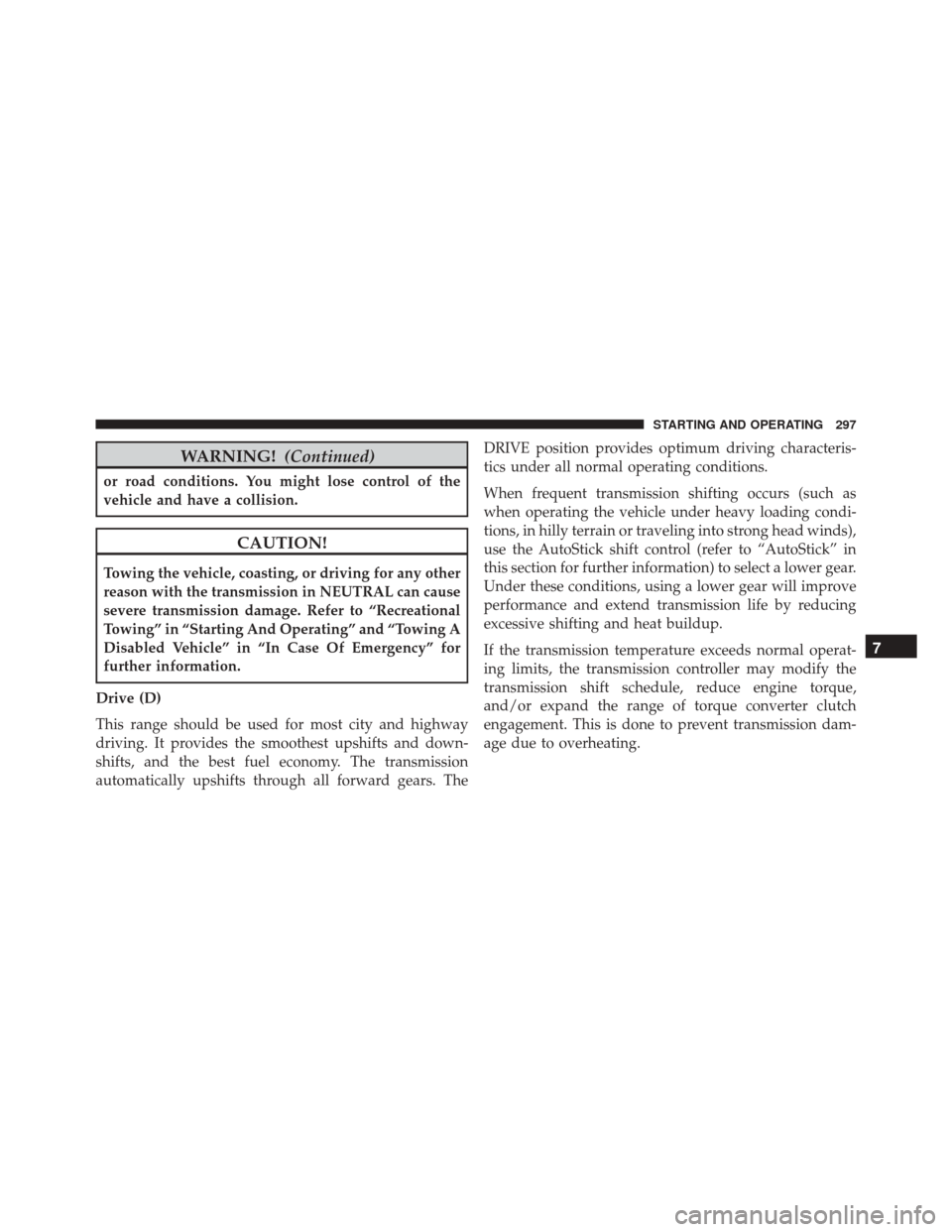
WARNING!(Continued)
or road conditions. You might lose control of the
vehicle and have a collision.
CAUTION!
Towing the vehicle, coasting, or driving for any other
reason with the transmission in NEUTRAL can cause
severe transmission damage. Refer to “Recreational
Towing” in “Starting And Operating” and “Towing A
Disabled Vehicle” in “In Case Of Emergency” for
further information.
Drive (D)
This range should be used for most city and highway
driving. It provides the smoothest upshifts and down-
shifts, and the best fuel economy. The transmission
automatically upshifts through all forward gears. The DRIVE position provides optimum driving characteris-
tics under all normal operating conditions.
When frequent transmission shifting occurs (such as
when operating the vehicle under heavy loading condi-
tions, in hilly terrain or traveling into strong head winds),
use the AutoStick shift control (refer to “AutoStick” in
this section for further information) to select a lower gear.
Under these conditions, using a lower gear will improve
performance and extend transmission life by reducing
excessive shifting and heat buildup.
If the transmission temperature exceeds normal operat-
ing limits, the transmission controller may modify the
transmission shift schedule, reduce engine torque,
and/or expand the range of torque converter clutch
engagement. This is done to prevent transmission dam-
age due to overheating.
7
STARTING AND OPERATING 297